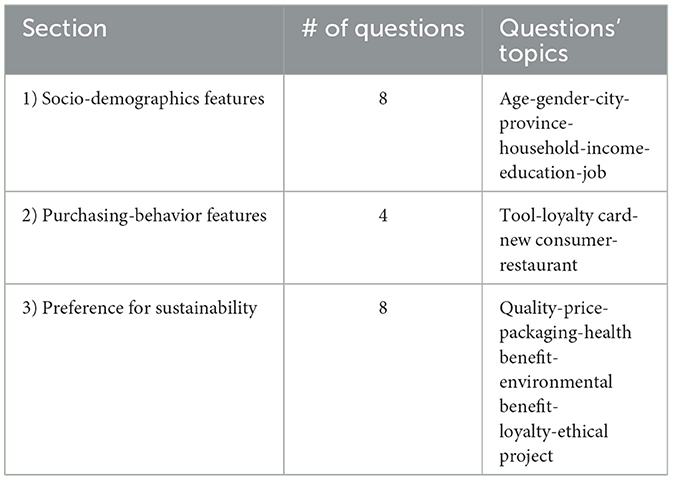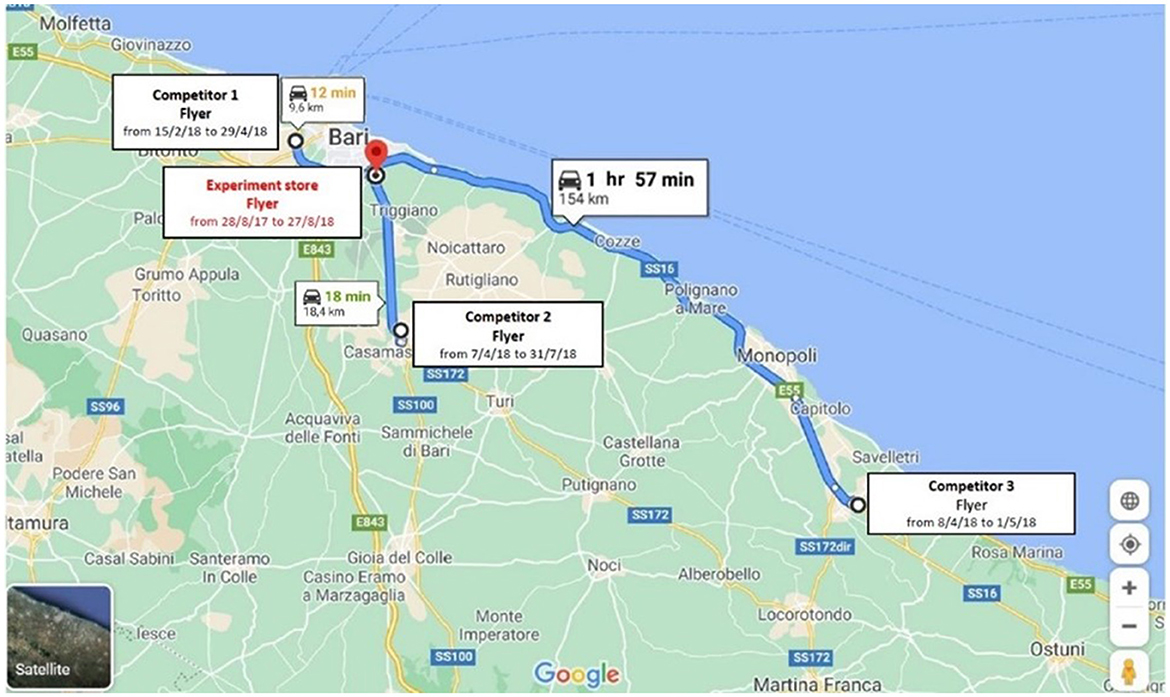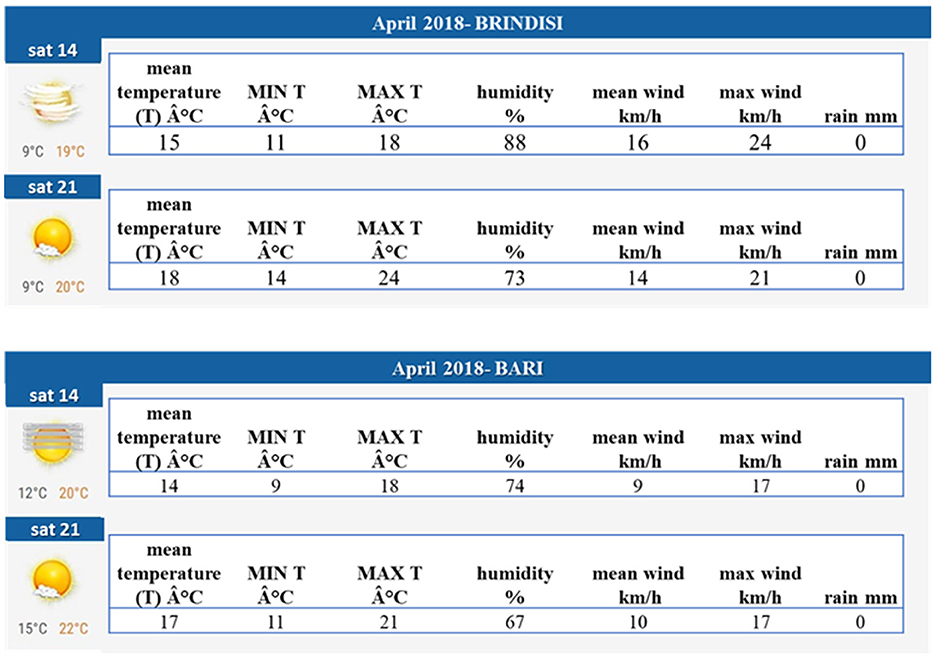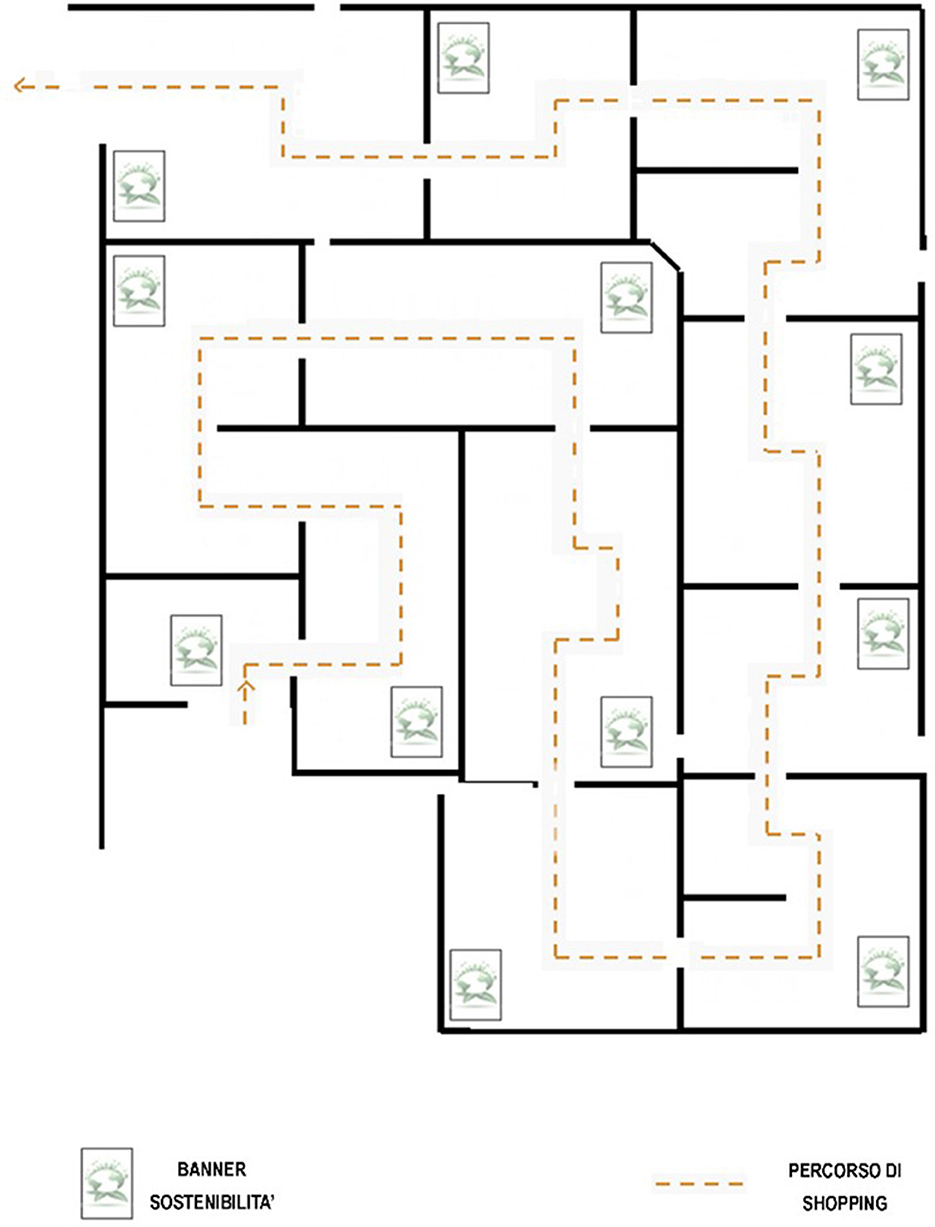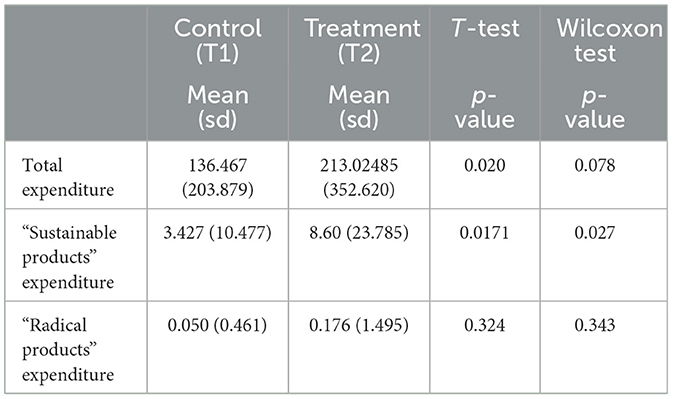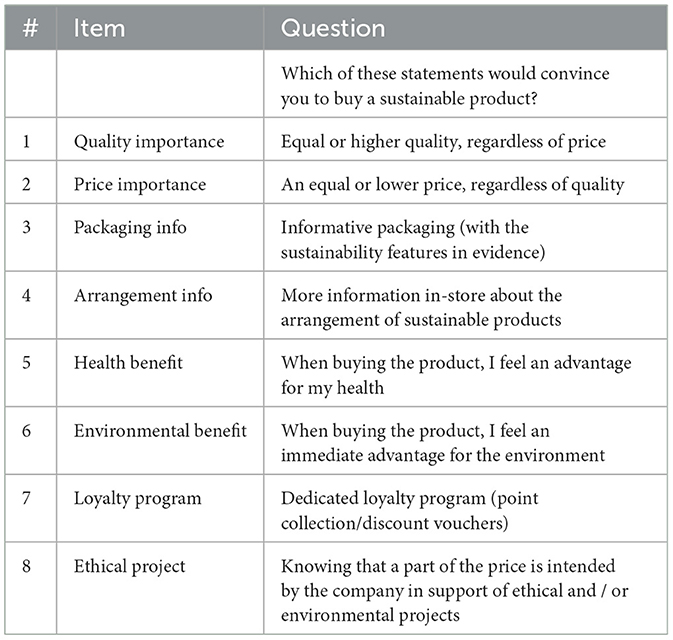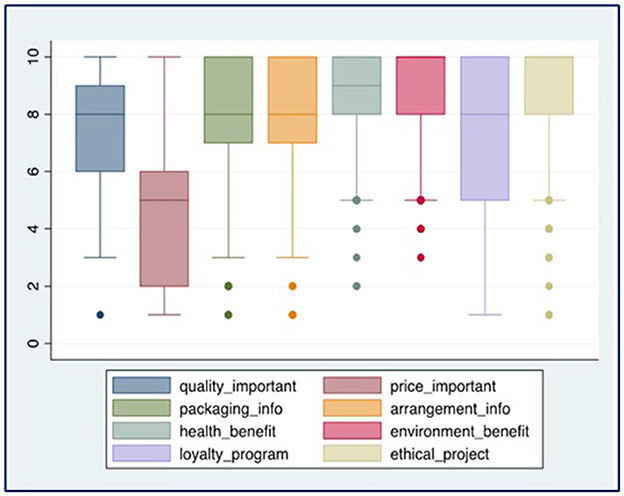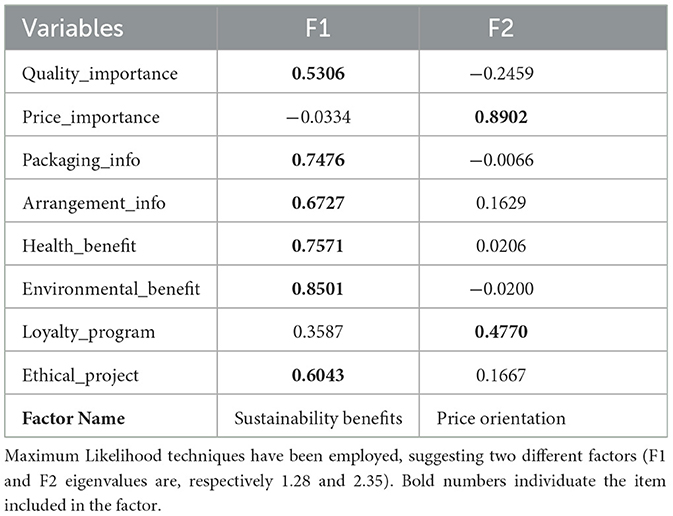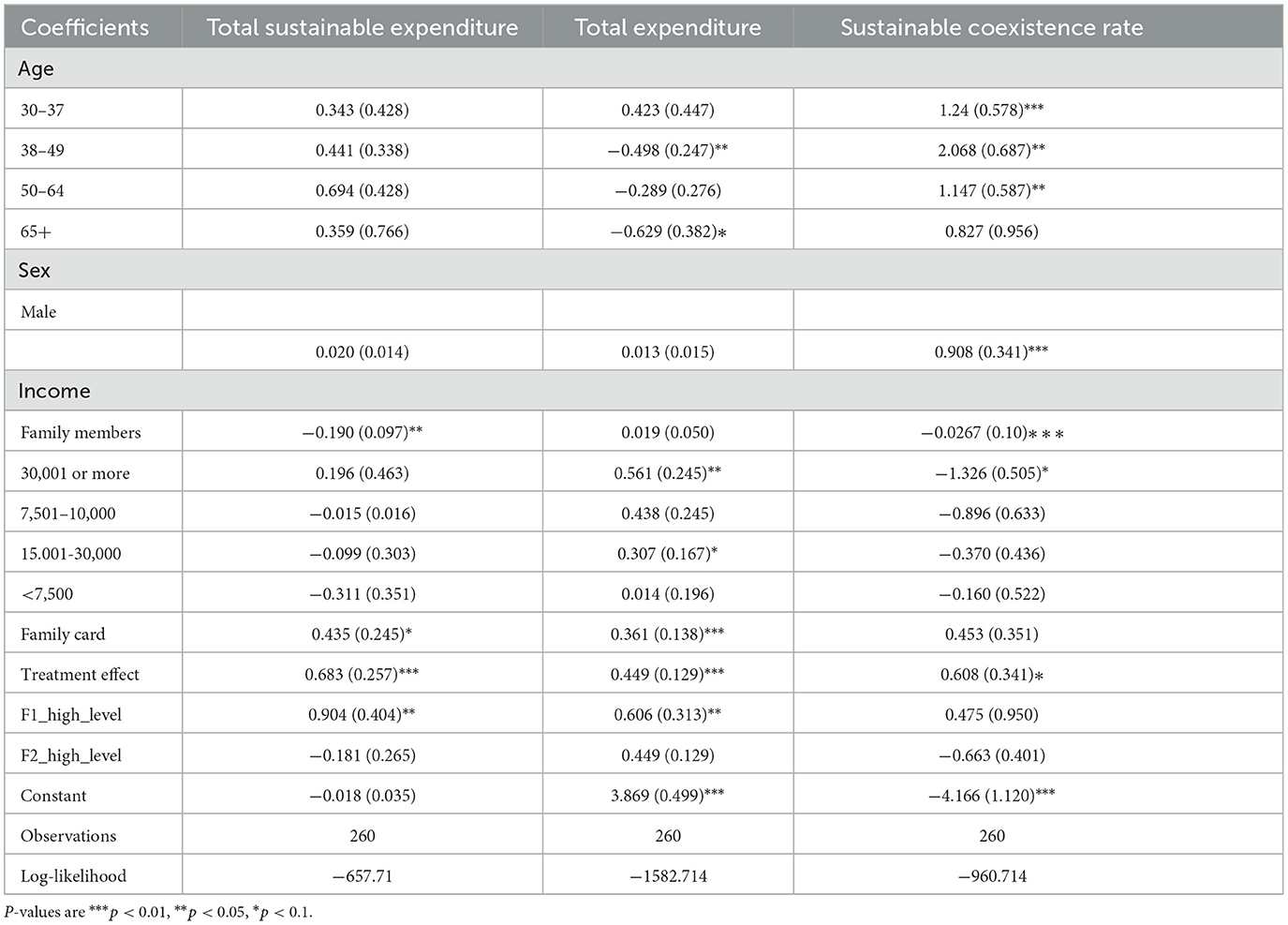Consumer analysis and the role of information in sustainable choices: A natural experiment
- 1Department of Economics, Management and Business Law, Bari University “Aldo Moro”, Bari, Italy
- 2Bioeconomy in Transition Research Group (Bit-RG), University of Rome, Unitelma Sapienza, Rome, Italy
“I shop therefore I am” (R. Campbell), or putting it differently, we are what we buy, and the way we make our purchases influences the future choices of economic decision-makers. Therefore, our decisions are crucial in defining the future sustainability of the whole system. Despite the plethora of initiatives introduced to enhance consumers' consciousness, the gap between ideal and real consumption attitude still exists and is a non-negligible problem, since subjects' sustainability intention is not always followed by sustainable consumption. Therefore, by employing a natural field experiment, the present work explores consumers' real behavior toward sustainable switching. Specifically, this study examines how the impact of targeted communication leads to a market basket sustainable shift. Indeed, we observe how the consumer's basket composition varies from control (where no targeted communication is included) to treatment (where specific and detailed communication is introduced through ad-hoc on-site banner signals). Results show the positive impact of the communication; after the introduction of the communication, the share of sustainable products is higher compared with the non-sustainable set of products. As a further extension, we consider the role played by product aesthetics: even if the effect is marked for sustainable products preserving the characteristics of the conventional substitute, such effect vanishes when a subset of radically different products is considered.
Highlights
- The Green and Sustainable shift requires the active involvement of consumers.
- Visual information can be crucial in raising consumers' awareness and real purchasing attitudes.
- The treatment effect (i.e., the introduction of an in-store banner) leads to an increase of the sustainable consumption share.
- The treatment effect vanishes when a subset of radically different products is considered.
1. Introduction
Along with sustainable production, more progress in boosting sustainable consumption is needed to accelerate Europe's transition toward more sustainable development (Lukman et al., 2016). However, there are still a broad range of barriers preventing consumers from more sustainable behavior [see De Jesus and Mendonça (2018)]. Accordingly, advancements of European countries in sustainable consumption will be driven by a combination of interventions, including the use of regulatory, market-based tools as well as information instruments through, for example, voluntary approaches and labeling (Pantzar et al., 2018). Lack of information is indeed a major issue as consumers' lack of interest and inadequate awareness were found to be key obstacles [see Luthra et al. (2016), Kirchherr et al. (2018)]. Thus, the provision of clear sustainability-related information to consumers can play a pivotal role, even though there is still considerable debate regarding its effects as this relationship should not be taken for granted and be further tested in real contexts. Indeed, it is a particularly challenging topic to investigate because of the difference between consumers' attitudes and consumers' behavior, known as the “attitude–behavior gap” (Hassan et al., 2016). This means that improved attitudes do not often translate into behavior, i.e., a purchase, and recent empirical analysis further investigated this phenomenon (Jacobs et al., 2018; Schäufele and Hamm, 2018; Wiederhold and Martinez, 2018).
Notably, several studies still outline the importance of analyzing consumer choices (O'Rourke and Ringer, 2016), notwithstanding the issues raised by a growing body of research that underlines the limits of addressing sustainable consumption (SC) by focusing on individual behavior. However, it has been emphasized that they should be framed in a practice-based approach, i.e., understanding “how products are appropriated as a consequence of the ways in which practices are socially ordered” (McMeekin and Southerton, 2012; p. 350).
A wide range of empirical approaches can be used to investigate individual consumer behavior (Akenji, 2014). In this respect, a natural experiment represents a particularly valuable tool as it can verify if consumers' attitudes are reflected in their actions in a real context (Morone et al., 2018). A number of experimental studies have been performed focusing on how different factors such as signage (Clement et al., 2015), decoration style (Li et al., 2015), merchandise quality (Chaney et al., 2015), store layout (Alawadhi and Yoon, 2016), visibility (Lu and Seo, 2015), aesthetic design (Murray et al., 2017; Baek et al., 2018), temperature (Huang et al., 2014), ambient scent (Leenders et al., 2019), and shopping tools (Morone et al., 2018) affect consumer choices. However, there are still few field experiments specifically investigating the effects of sustainability-related information. Against this background, this paper adds to the existing attitude-behavior gap literature, by performing a natural experiment, testing whether communication tools may affect consumer attitudes and behavior toward sustainable products.
The article is structured as follows. Section 2 introduces the relevant background literature and Section 3 describes the methods and the experiment design used; Section 4 presents and discusses the results, and Section 5 reports some concluding remarks and policy implications.
2. Literature review
A relevant part of the literature on sustainable consumption (SC) attempts to identify the factors that affect subjects' purchases (Li, 2020; Haider et al., 2022) and consequently identify the actions that might reduce the attitude-behavior gap. The latter is caused by a wide range of different factors that can be grouped into three main categories, i.e., individual, social, and situational (Terlau and Hirsch, 2015).
First, regarding the individual category, socio-economic and socio-demographic features have been investigated. Specifically, regarding age (Straughan and Roberts, 1999), the general belief is that younger individuals have more interest in environmental issues. Additionally, providing adequate education about SC starting from a young age is tantamount to planting a seed that will grow in the future, if it is fed by the right stimuli (Davis, 1998). In fact, the higher the education level is, the greater the degree of green-purchase intention is. An interesting study has shown that the higher the education level, the stronger the relationship between eco-labels and purchase intention of green products (Chekima et al., 2016). The level of income follows the pattern of the education level, both are positively correlated with “being green.” The higher the level of income, regarding consumers concerned about environmental issues, the lower their interest in premium price, which is typical of sustainable products (Chekima et al., 2016). Different levels of consumption and attention to the price are also related to gender. The literature points out that this discrepancy depends on the different aspects that characterize men and women but is mainly encouraged by the stereotypes instilled by society; thus, women are more involved in SC (Bloodhart and Swim, 2020). It has been found that women are more likely than men to follow an attitude connected with green behavior, even though purchases related to their child need to be further investigated since budget constraints appear as a key barrier (Migheli, 2021). Moreover, it was discovered that nations with women in governmental positions take environmental issues more into consideration (Norgaard and York, 2005), even though they consume more than men, they try to have a more sustainable behavior. One explanation may be that men feel uncomfortable when engaging in pro-environmental behavior because it implies a “feminine” stigma (Johnson et al., 2013). Different studies affirmed that men have more knowledge about environmental issues than women (MacDonald and Hara, 1994). Their approach to the problem is more technological and elaborate than directly applied (Diamantopoulos et al., 2003). However, even though socio-demographic and socio-economic characteristics are useful in understanding human behavior, they offer only a partial explanation about the nudging factors that can be introduced to foster the “green stimulus.” In addition, habits play a pivotal role in shaping individual choices as routines strongly affect consumers consumption patterns (Gram-Hanssen, 2007; Godin and Langlois, 2021).
Notably, social factors such as the influence of social norms, acceptability, culture that varies from different countries, and often also at a local level, must be considered [see Minton et al. (2018), Slocum et al. (2022)]. Depending on countries' cultures, the importance given to environmental knowledge varies and consequently also the green purchasing behavior of individuals (Halder et al., 2020). “Culture is instilled in an individual's values and lifestyle, exerting a considerable influence on consumer behavior” (Sheng et al., 2019).
Finally, with reference to situational factors that a consumer faces during their purchases, price and information are considered two key factors to be investigated as a higher price (Choi and Ng, 2011) or the presence of informative asymmetries does not necessarily lead to a “non-purchase” of a product considered sustainable (Chang et al., 2021).
Against this background, the current work investigates how consumers' awareness might impact subjects' involvement in sustainable purchasing, given the pivotal role that marketing can have in paving the way for sustainable growth (Bolton, 2022).
The moral values of the subjects provide us with information on their preferences and their behaviors, especially regarding SC (Salciuviene et al., 2022). The more involved the citizens are with environmental and nature concerns (Dong et al., 2020), the more likely they are to cooperate with the environmental cause (De Matteis et al., 2021), and then to buy green products (Schuhwerk and Lefkoff-Hagius, 1995). However, according to Laroche et al. (2002), it seems that most of them are only willing to act like green consumers, under the condition that this behavior does not involve a sacrifice in their lifestyle. Over the years this vision has evolved, individuals had to make a trade-off between self-sacrifice and environmental benefit. Let us call these sacrifices “cost to consumer,” e.g., the extra time and effort exerted during shopping, due to the inconvenience of not being able to purchase all of their goods in the same shop, which also implies consumption habits changing (White and Simpson, 2013). This internal fighting, between benefiting the environment or themselves is regulated by a moral identity strongly conditioned by the feelings of responsibility for environmental damages. In fact, moral-identity-activated consumers prefer eco-friendly products (Wu and Yang, 2018). As Michaud and Llerena (2011), show in their work, “consumers are likely to perceive remanufactured products as “green” only if they are properly informed.” The literature shows that consumers are worried about environmental problems, and they are trying to modify their behavior to contribute positively (Young et al., 2010). Thus, it allows us to suppose that we can identify a more reasonable consumer, willing to inquire. Many researchers examining the SC field have wondered, what is the most effective way to promote the purchase of “green products”? (Geiger et al., 2018). The common conclusion was providing individuals with accurate information about SC, because the more the consumers are informed, the more they will adopt “perfect information” in their decision-making process, which will lead them to sustainability (Wichman, 2017). Considering the purchasing process, an unexplored stimulus is the use of communication tools.
As previously mentioned, environmental policies, informative store labels, and eco-labels have an influence on consumers. It is important to act in the purchasing process to try to smooth out the “attitude-behavior gap” as much as possible. This gap may depend on various factors, as previously mentioned, however, the lack of information is one of the factors that may have greater weight (Geiger et al., 2018; Simeone and Scarpato, 2020). This “attitude-behavior gap” due to lack of information may be solved by intervening in the decision-making process. An effective way may be to propose communication tools, e.g., explicative banners, outlining the company ethics and commitment concerning sustainability. In this way, consumers might support such efforts, directing their decision toward the sustainable direction proposed by the brand.
3. Methods and experimental design
3.1. Methods and research hypothesis
Among all the different experimental approaches [see Kagel and Roth (2016) for a review], field experiments are an advantageous replacement method for non-experimental tests of consumer theory, offering the opportunity to observe the subjects' effective behavior occurring in a natural setting.
This type of experiment considers a situation where individuals naturally undertake the tasks that the researchers want to analyze, such as the purchasing process in a store. They neither know that they are being randomized into treatment nor that their behavior is subsequently scrutinized. The main advantage of this approach is the possibility of obtaining empirical evidence by isolating the effect of the specific stimuli introduced (Caniglia et al., 2017).
In this article, a natural field experiment was performed to test whether specific information about SC inside the store may trigger individuals' sustainable preferences and shopping behavior.
The literature shows that these natural experiments are a good method to test the importance of the wealth of information during the individual decision-making process (Pichert and Katsikopoulos, 2008). In our case, we used communication tools, i.e., banners explaining sustainable product characteristics in the store.
Drawing on the literature mentioned in the section above, the following hypotheses were formulated for this research:
RQ1: Does information influence consumer habits, orienting specific consumption of sustainable products?
In-store banners do not foster subjects to purchase the suggested product.
In the case of rejection, it can be concluded that sustainability-related information could affect consumer behavior. In the case of rejection, the overall impact of an in-store campaign on the purchase of sustainable products can be assessed.
RQ2: Does salient sustainable information increase the total consumers' expenditure within stores adopting and promoting sustainable values?
A sustainable-oriented environment does not enhance consumers' total expenditure. Whether subjects are more concerned with quality and transparency of information, then there will be a positive impact on the total expenditure, since they are aware that they are spending their money at a point of sale which takes care of sustainable issues.
Subsequent research by consultants such as Bain & Company affirmed that loyal customers are more profitable to a firm, but at the same time several studies show that consumers are multi-brand loyal to several products and services. Thus, it implies that the most profitable consumers for one firm will most probably be the most profitable customers of its competitors as well. This statement does not stop us from affirming that loyal consumers can increase store turnover and at the same time produce the highest receipts (Morone et al., 2018). The Loyal Report 2019,1 through a survey of 55 thousand consumers in more than 20 different markets affirms that loyalty influence continues to be stronger year over year. They registered a 6.4 increase in satisfaction, and part of it represents an increase in spending for the loyalty brand.
3.2. Experimental design
To test our research hypothesis, the natural experiment was conducted in the middle of April 2018 in a large store in Southern Italy of a multinational company that sells furniture, furnishing accessories, and household articles. The experiment was carried out on randomly selected consumers and the design consisted of two steps: (i) a control phase, and (ii) a treatment phase. In the control phase, consumers' demographic characteristics, preferences, and attitudes toward sustainability were collected through a questionnaire. In this phase, there were no visual tools informing consumers about the sustainability characteristics of sustainable products available in the store. In the treatment phase, several banners were introduced without altering the set of products available in the store. In particular, different generic banners describing the commitment of the retailer toward sustainability and specific banners depicting the main sustainability characteristics were positioned near and on top of the sustainable products present in the store. Moreover, the same questionnaire (see Table 1 for a summary) was presented to the treatment subjects to detect the effect of the proposed treatment.
The control and the treatment were conducted 1 week from each other,2 hence dealing with a between design.
Before proceeding with the illustration of the experimental design it is appropriate to specify that, when we analyze the effect of a stimulus in a specific environment it is important to take into consideration not only the internal factors in the store that may influence the results of the experiment, but also verify the absence of any type of difference, generated by intervening variables, between the two phases of the experiment. Considering, for example, the promotion policy of the competitors related to discounts, specific occasions (such as Christmas), and some aspects that may impact the affluence of consumers in a store, such as the weather conditions.
For these reasons, Figures 1, 2 are reported below for clarification regarding the possibilities of intervening variables. Figure 1 tracks the distance between the store of our experiment and its competitors in the near area. In every store, we have no promotion or flier published on a date closer to or coinciding with our experiment. In Figure 2, we can observe the climatic evolution in the two dates of our experiment, taking into consideration the area of our store and the competitors. The mean temperature is almost the same and we do not observe rainy conditions.
Specifically, the experiment proceeded as follows:
i. Control phase: the experiment started on the 14th of April 2018, involving 182 subjects. In this case, as mentioned above, no visual information about the sustainable products present in the store was provided. The subjects were presented with a self-compiled questionnaire that was administered beyond the store's cashier barrier. In this way, it was also possible to record the receipts and link them to the survey. This aspect is extremely important because it enables the investigation of the relationship between subjects' attitudes, described in the questionnaire with their actual consumption choice.
ii. Treatment phase: after 1 week, on the 21st of April, the same questionnaire was administered to 116 subjects. As mentioned before, in this case, several banners were displayed in the store. Moreover, during the control phase, we kept track of the receipts.
iii. No other changes were made between the control and treatment phases.
To have a visual location of the products, we reported the plan of the store. As we can see from Figure 3, sustainable products are distributed as-good-as-random3 evenly within the store. In the map, we can observe the precise points in which the banners were positioned during the treatment phase.
As specified in the description of the treatment phase, a series of specific banners have been placed within the store in reference to a subset of sustainable products. The sample was chosen randomly but based on two conditions: (i) the availability of the store for the positioning of the signs, and (ii) the items contain the main sustainable characteristics considering all the sustainable products of the store. From now on we will refer to this subset of products using the “radical sustainable products” label.
Figure 4 highlights the difference between the control and treatment phases, by showing group c (“sustainable radical products”), while Table 2 briefly describes the structure of the questionnaire (for the complete version of the questionnaire see Appendix 1).
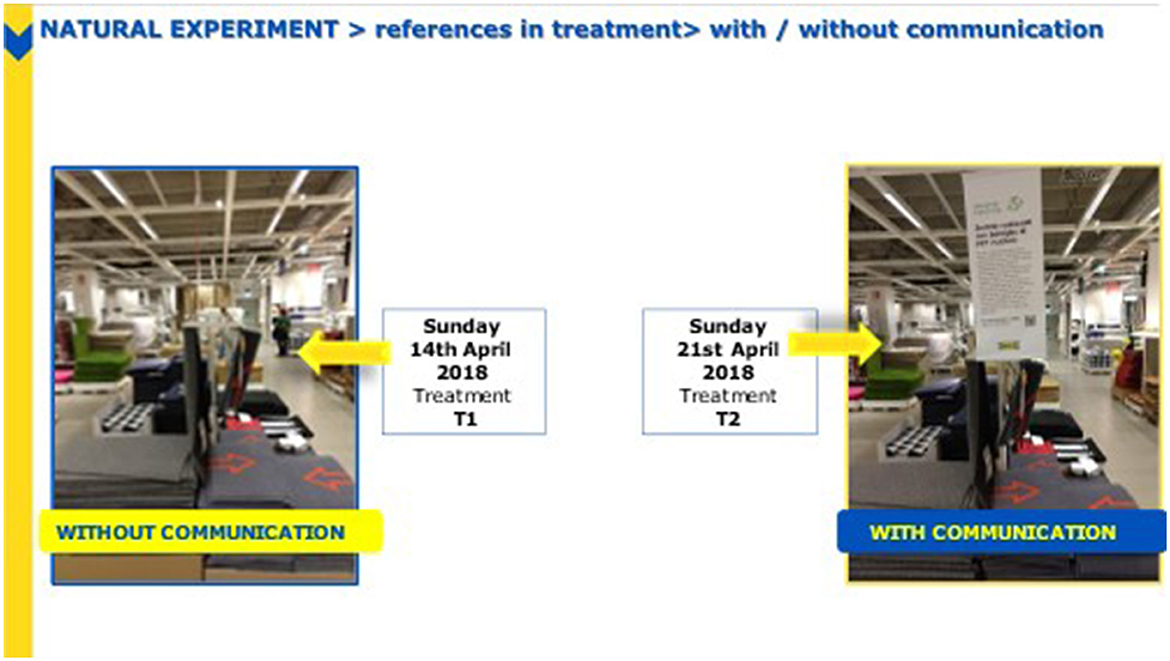
Figure 4. Graphical description of the experiment. In the figure “without communication” we can see an example of a specific banner, the signage shows a message in Italian that emphasizes the sustainable characteristics of the product in question, a doormat. Below is the English translation of the message communicated: “POSITIVE IMPACT: Doormats made from recycled PET bottles: For us, waste is a resource, in fact we use recycled PET polyester to produce our doormats. The latter have all the features you expect from them: they are equipped with a non-slip back, they keep the floor clean, they resist wear and are easy to clean, simply by rubbing them or washing them with water. These doormats are also an environmentally smart choice, taking a step toward a more sustainable future. Sustainability in (name of the store)” Further examples of signage are shown in Appendix 2.
Starting from the assessment of the sample homogeneity, the next step was analyzing the main response variable of the experiment, that is, checking whether differences in the expenditure arise moving from one session to the other. Afterward, an investigation was carried out on how subjects' preferences influence their behavior, controlling for some socio-demographic characteristics. All of these aspects will be discussed in the next section.
4. Results and discussion
To validate the sample randomization procedure, we first controlled whether the two samples can be considered homogeneous, as in this case, it can be concluded that statistical differences in the response variable can be attributed to the treatment effect. We additionally provide a post-hoc power test indicating the probability of correctly accepting the alternative hypothesis when it is true. The power achieved is sufficiently high to accurately conclude an increase in the average expenditure in the treatment phase, while it poorly evidences the possibility to accept differences among average socio-demographics.
Table 2 shows the socio-demographic features of the two considered treatments. In both cases, the sample is characterized by a slightly higher share of female participants than male participants. Which is appropriate, given our focus on house-related purchases. The age of participants ranges from 38 to 49 years old and for the most part, are high school graduates currently working as employees.
A z-test of proportions was conducted, showing that there are no statistical differences in age, gender, education, and family members, thereby, the sample can be considered homogeneous.
One of the most interesting results is the marked differences in the average level of expenditure with reference to (1) expenditure on “sustainable products,” (2) expenditure on “radical sustainable products,” and (3) level of total expenditure.
Regarding the first group (1), when considering all other variables being equal, we found expenditure increases in the treatment phase. Therefore, this preliminary result can assume that the increased purchasing of “sustainable products” is due to the introduction of visual information. Referring to the second group (2), we collected a very low number of observations in both phases, meaning that in general, the participants are not interested in purchasing these types of products, even when a clear explanation about their sustainability is provided. Figure 5 depicts a graphical comparison of the different types of expenditures moving from the control to the treatment session, while Table 3 displays the non-parametric test. As can be seen, the variable is not normally distributed. However, in this first session of the analysis, a t-test4 and a Wilcoxon Rank-Sum test were conducted to check robustness. Statistical tests confirm an increase in the total expenditure and the expenditure on “sustainable products”.5

Figure 5. (A) Total expenditure, (B) expenditure in “sustainable products,” (C) “radical sustainable products” and (D) sustainable coexistence rate distribution.
Given the increase in both types of expenditures, to assess the effect of our stimulus, we have generated a new variable: the Sustainable Coexistence Rate (Figure 5). It is the proportional relationship between two classes. In our case, it is the ratio between the total expenditure of sustainable products and the total expenditure of all the other non-sustainable6 items in the store. Subsequently, through non-parametric tests (Wilcoxon test) we verified whether these rates changed between the control and the treatment phases. We can reject the null hypothesis (p-value 0.0417) and highlight a difference in this rate. This means, that the presence of the banner increases the expense of sustainable products in a manner more than proportional to the increase in total expenditure. Additionally, for the sake of soundness, a Gamma regression model, that best fits the shape of the distribution, was run at the end of the session.
To identify attitudes regarding sustainability, participants were asked to attribute a score to a set of eight statements by using a Likert scale with values from 1 to 10. They evaluated the importance that quality, packaging information, health benefits, loyalty programs, price, arrangement information, environmental benefits, and eventual ethical projects in which a product is involved, have in consumers' consumption decisions (see Table 4).
Results are reported in Figure 6. As can be seen, subjects are more concerned with quality, informativity, and sustainability-related issues (rather than price convenience).7 However, it is important to check whether subjects' attitudes drive their consumption choices. In this case, consumers more concerned with quality/sustainability issues are prompted to increase their spending on sustainable products. Therefore, after collecting information on the consumers' intentional behavior, by assessing their concerns about different factors, it was subsequently compared to their real purchasing behavior. Specifically, a factor analysis to detect whether subjects' preferences can be collected and attributed to some common underlying attitudes (i.e., factors) was performed. As mentioned, we used eight different variables correlated with preferences toward sustainability. Two different factors were identified: each factor is composed of the variables in bold numbers highlighted in Table 5. Looking at the variables that compose the factors, we can identify a (1) quality/sustainability -oriented (F1) and a (2) price-oriented factor (F2).
Each index was constructed by employing the simple average among the selected items. To facilitate the interpretation of the results, two levels of price orientation and sustainable benefits were identified. A high level of the factor was reached, if the average among the items that compose it was greater than five (therefore of the average of the Likert scale), if it were less than five, it would be a low-level factor. In this part, a gamma regression model was employed. The class of gamma regression models assumes that the dependent variable is gamma distributed and that its meaning is related to a set of regressors through a linear predictor with unknown coefficients and a link function. In our case, we employ a logarithmic link function (values have been appropriately re-scaled to deal with 0) and an iteratively reweighted least-squares (IRLS) as a maximization algorithm. As the response variable, the total spending on all the sustainable products has been employed and the total expenditure in two separate regression models.
Regression results (Table 6) show that there is a positive treatment effect on both, levels of total expenditure and expenditure on “sustainable products.” It is also clear that while price orientation (F2_high_level) does not influence total expenditure, the awareness of product quality/sustainability (F1_high_level) increases both expenditures on “sustainable products” and total expenditure. This shows that the total receipts of those who pay attention to product quality/sustainability increase with this type of communication. As we can see from the results, the Sustainable Coexistence Rate is also affected by the treatment. This explicates in a clear way that, even if the introduction of the banner has a significant effect on total expenditure, it is stronger on sustainable products.
Concerning the hypothesis made, it was found that:
R1: In-store banners do not foster subjects to purchase “radical sustainable products.”
There are no statistical differences in the receipt total in the two phases. By contrast, they increased “sustainable products” purchasing. In-store banner positively affects consumers' attitudes toward “sustainable products.” Promoting the sustainability of the products fosters the subjects' preferences regarding the topic. This can be seen from an increase in the expenditure of these products, as evidenced by both non-parametric tests and regressions, especially observing the positive effect of the treatment on the Sustainable Coexistence Rate. This underlines how the increase in sustainable expenditure can be attributed to the stimulus introduced and not to the effect of intervening variables that cannot be controlled (such as the effect of promotional policies, special holidays, or weather conditions).
R2: A sustainable-oriented environment enhances consumers' total expenditure.
Advertising product sustainability increases overall trustworthiness in the store, which is reflected in higher spending. This result has been proved after having tested sample homogeneity.
Furthermore, we find that the focus on product quality and disclosure drives consumers toward sustainable consumption.
The analysis conducted leads to several implications. First, the policy adopted—the use of banners to sponsor sustainable products—leads to a higher general level of spending on “sustainable products.” However, the same does not apply to “radical sustainable products.” This seems to suggest that consumers are still strongly influenced by their habits. Accordingly, they are not yet willing to give preference to greater sustainability in exchange for aesthetic features.
5. Conclusions and managerial implications
This paper aimed at investigating, through a natural experiment, whether the consumer's behavior is stimulated toward the purchase of sustainable products after introducing targeted visual communication within the store. First, an increase in the total expenditure can be observed, especially in sustainable products. Moreover, the econometric model shows that preferences toward quality/sustainability issues matter in purchasing sustainable products.
Considering this case study from a different perspective, we can find interesting managerial suggestions. First, the in-store banner is a non-invasive solution, that could imply, as indicated by our case study, an increase in total spending. It can be argued that such a tool increases consumers' awareness and responsibility. Different factors might motivate subjects to invest in sustainability. Indeed, the effect related to loyalty programs indicates that loyal consumers spend more. Thus, they are more incentivized to support brand initiatives, such as sustainable-oriented initiatives. Therefore, from a managerial point of view, the implementation of different in-store marketing strategies might nudge consumers to pro-actively contribute to several social and environmental causes.
The results obtained refer to a case study, further surveys should be carried out to verify and increase the accuracy of the external validity of the results obtained. For instance, a natural extension of the current work might focus on how the quantity and the quality of the information released influence consumers' choices.
On the one hand, our results support existing literature on the positive effect of information in nudging green decisions (Lin and Nayga Jr, 2022; Permana and Sanjaya, 2022). On the other hand, it provides interesting insights considering the heterogeneity of product characteristics. “One size does not fit all,” and the product heterogeneity can vary the intensity of the information effect. It might be worth analyzing the extent to which aesthetics matters in subjects' preferences. In this way, while existing literature is focusing on the heterogeneity of consumers' preferences due to the heterogeneity of product characteristics, this can increase or reduce the size of the treatment effect. While generic communication works, a more detailed analysis should be carried out to understand how to improve communication for the promotion of niche products with characteristics that are more difficult for consumers to accept.
To clarify, the article at hand demonstrated that customers are not prone to purchase sustainable products extremely different from their conventional counterpart. It might pay to investigate how such features matter in shaping preferences in order to identify the most suitable production methods to convert consumption.
Data availability statement
The raw data supporting the conclusions of this article will be made available by the authors, without undue reservation.
Ethics statement
Ethical review and approval was not required for the study involving human participants in accordance with the local legislation and institutional requirements. Written informed consent to participate in this study was not required from the participants in accordance with the national legislation and the institutional requirements.
Author contributions
All authors listed have made a substantial, direct, and intellectual contribution to the work and approved it for publication.
Conflict of interest
The authors declare that the research was conducted in the absence of any commercial or financial relationships that could be construed as a potential conflict of interest.
Publisher's note
All claims expressed in this article are solely those of the authors and do not necessarily represent those of their affiliated organizations, or those of the publisher, the editors and the reviewers. Any product that may be evaluated in this article, or claim that may be made by its manufacturer, is not guaranteed or endorsed by the publisher.
Supplementary material
The Supplementary Material for this article can be found online at: https://www.frontiersin.org/articles/10.3389/frevc.2022.1044206/full#supplementary-material
Footnotes
1. ^The Loyalty Report 2019 is recognized as the industry's longest standing and largest global study on customer engagement, loyalty attitudes, behaviors, drivers, and disruption. https://info.bondbrandloyalty.com/loyalty-report-2019.
2. ^We checked whether or not participants in the baseline ever participated in the treatment, asking them, if they had already completed it, before administering the questionnaire in the treatment phase.
3. ^The timing of the retailer's messaging intervention was as-good-as-random.
4. ^In this case it is (asymptotically) valid for a large sample.
5. ^As a check for robustness, we also account for the presence of outliers, finding no different results.
6. ^With non-sustainable products we considered all the items in the store with characteristics different from the sustainable category, for example the production of items without using recycled material.
7. ^T-test conducted evidenced that all the pair-wised comparison with the other 7 issues are very statistically significant.
References
Akenji, L. (2014). Consumer scapegoatism and limits to green consumerism. J. Clean. Prod. 63, 13–23. doi: 10.1016/j.jclepro.2013.05.022
Alawadhi, A., Yoon, S. Y. (2016). Shopping behavioural intentions contributed by store layout and perceived crowding: an exploratory study using computer walk-through simulation. J. Int. Des. 41, 29–46. doi: 10.1111/joid.12077
Baek, E., Choo, H. J., Lee, S. H. M. (2018). Using warmth as the visual design of a store: intimacy, relational needs, and approach intentions. J. Busi. Res. 88, 91–101. doi: 10.1016/j.jbusres.2018.03.013
Bloodhart, B., Swim, J. K. (2020). Sustainability and consumption: what's gender got to do with it?. J. Soc. Iss. 76, 101–113. doi: 10.1111/josi.12370
Bolton, R. N. (2022). The convergence of sustainability and marketing: transforming marketing to respond to a new world. Aust. Mark. J. 30, 107–112. doi: 10.1177/18393349211005200
Caniglia, G., Schäpke, N., Lang, D. J., Abson, D. J., Luederitz, C., Wiek, A. (2017). Experiments and evidence in sustainability science: a typology. J. Clean. Prod. 169, 39–47. doi: 10.1016/j.jclepro.2017.05.164
Chaney, D., Lunardo, R., Saintives, C. (2015). In-store quality (in) congruency as a driver of perceived legitimacy and shopping behavior. J. Retail. Consum. Serv. 24, 51–59. doi: 10.1016/j.jretconser.2015.02.002
Chang, T. W., Chen, Y. S., Yeh, Y. L., Li, H. X. (2021). Sustainable consumption models for customers: investigating the significant antecedents of green purchase behavior from the perspective of information asymmetry. J.f Environ. Plann. Manag. 64, 1668–1688. doi: 10.1080/09640568.2020.1837087
Chekima, B., Wafa, S. A. W. S. K., Igau, O. A., Chekima, S., Sondoh Jr, S. L. (2016). Examining green consumerism motivational drivers: does premium price and demographics matter to green purchasing?. J. Clean. Prod. 112, 3436–3450. doi: 10.1016/j.jclepro.2015.09.102
Choi, S., Ng, A. (2011). Environmental and economic dimensions of sustainability and price effects on consumer responses. J. Bus. Ethics 104, 269–282. doi: 10.1007/s10551-011-0908-8
Clement, J., Aastrup, J., Forsberg, S. C. (2015). Decisive visual saliency and consumers? in-store decisions. J. Retail. Consum. Serv. 22, 187–194. doi: 10.1016/j.jretconser.2014.09.002
De Jesus, A., Mendonça, S. (2018). Lost in transition? Drivers and barriers in the eco-innovation road to the circular economy. Ecol. Econ. 145, 75–89. doi: 10.1016/j.ecolecon.2017.08.001
De Matteis, F., Preite, D., Striani, F., Borgonovi, E. (2021). Cities' role in environmental sustainability policy: the Italian experience. Cities 111, 102991. doi: 10.1016/j.cities.2020.102991
Diamantopoulos, A., Schlegelmilch, B. B., Sinkovics, R. R., Bohlen, G. M. (2003). Can socio-demographics still play a role in profiling green consumers? A review of the evidence and an empirical investigation. J. Bus. Res. 56, 465–480. doi: 10.1016/S0148-2963(01)00241-7
Dong, X., Liu, S., Li, H., Yang, Z., Liang, S., Deng, N. (2020). Love of nature as a mediator between connectedness to nature and sustainable consumption behavior. J. Clean. Prod. 242, 118451. doi: 10.1016/j.jclepro.2019.118451
Geiger, S. M., Fischer, D., Schrader, U. (2018). Measuring what matters in sustainable consumption: an integrative framework for the selection of relevant behaviors. Sust. Develop. 26, 18–33. doi: 10.1002/sd.1688
Godin, L., Langlois, J. (2021). Care, gender, and change in the study of sustainable consumption: a critical review of the literature. Front. Sustain. 92. doi: 10.3389/frsus.2021.725753
Gram-Hanssen, K. (2007). Consuming technologies—Developing routines. J. Clean. Prod. 16, 1181–1189 doi: 10.1016/j.jclepro.2007.08.006
Haider, M., Shannon, R., Moschis, G. P. (2022). Sustainable consumption research and the role of marketing: a review of the literature (1976–2021). Sustainability 14, 3999. doi: 10.3390/su14073999
Halder, P., Hansen, E. N., Kangas, J., Laukkanen, T. (2020). How national culture and ethics matter in consumers' green consumption values. J. Clean. Prod. 265, 121754. doi: 10.1016/j.jclepro.2020.121754
Hassan, L. M., Shiu, E., Shaw, D. (2016). Who says there is an intention–behaviour gap? Assessing the empirical evidence of an intention–behaviour gap in ethical consumption. J. Bus. Ethics 136, 219–236. doi: 10.1007/s10551-014-2440-0
Huang, X. I., Zhang, M., Hui, M. K., Wyer Jr, R. S. (2014). Warmth and conformity: The effects of ambient temperature on product preferences and financial decisions. J. Consum. Psychol. 24, 241–250. doi: 10.1016/j.jcps.2013.09.009
Jacobs, K., Petersen, L., Hörisch, J., Battenfeld, D. (2018). Green thinking but thoughtless buying? An empirical extension of the value-attitude-behaviour hierarchy in sustainable clothing. J. Clean. Prod. 203, 1155–1169 doi: 10.1016/j.jclepro.2018.07.320
Johnson, S. L., Dahl, J., Swim, J. K., Vescio, T. K. (2013). The Gender-Stereotypic Nature of Climate Change Positions. Paper presented at the Society for Personality and Social Psychology. Austin, TX. doi: 10.1037/e514472015-187
Kagel, J. H., Roth, A. E. (Eds.). (2016). The Handbook of Experimental Economics (Vol. 2). Princeton University Press. doi: 10.1515/9781400883172
Kirchherr, J., Piscicelli, L., Bour, R., Kostense-Smit, E., Muller, J., Huibrechtse-Truijens, A. (2018). Barriers to the circular economy: evidence from the European Union (EU). Ecol. Econ. 150, 264–272. doi: 10.1016/j.ecolecon.2018.04.028
Laroche, M., Tomiuk, M. A., Bergeron, J., Barbaro-Forleo, G. (2002). Cultural differences in environmental knowledge, attitudes, and behaviours of Canadian consumers. Can. J. Administ. Sci. 19, 267–282. doi: 10.1111/j.1936-4490.2002.tb00272.x
Leenders, M. A., Smidts, A., El Haji, A. (2019). Ambient scent as a mood inducer in supermarkets: the role of scent intensity and time-pressure of shoppers. J. Retail. Consum. Serv. 48, 270–280. doi: 10.1016/j.jretconser.2016.05.007
Li, M. (2020). Review of consumers' green consumption behavior. Am. J. Indust. Bus. Manag. 10, 585–599 doi: 10.4236/ajibm.2020.103039
Li, Y., Fu, H., Huang, S. S. (2015). Does conspicuous decoration style influence customer's intention to purchase? The moderating effect of CSR practices. Int. J. Hospital. Manag. 51, 19–29. doi: 10.1016/j.ijhm.2015.08.008
Lin, W., Nayga Jr, R. M. (2022). Green identity labeling, environmental information, and pro-environmental food choices. Food Policy 106, 102187. doi: 10.1016/j.foodpol.2021.102187
Lu, Y., Seo, H. B. (2015). Developing visibility analysis for a retail store: a pilot study in a bookstore. Environ. Plann. B Plann. and Des. 42, 95–109. doi: 10.1068/b130016p
Lukman, R. K., Glavi,č, P., Carpenter, A., Virti,č, P. (2016). Sustainable consumption and production—Research, experience, and development—The Europe we want. J. Clean. Prod. 138, 139–147. doi: 10.1016/j.jclepro.2016.08.049
Luthra, S., Mangla, S. K., Xu, L., Diabat, A. (2016). Using AHP to evaluate barriers in adopting sustainable consumption and production initiatives in a supply chain. Int. J. Prod. Econ. 181, 342–349. doi: 10.1016/j.ijpe.2016.04.001
MacDonald, W. L., Hara, N. (1994). Gender differences in environmental concern among college students. Sex Roles 31, 369–374. doi: 10.1007/BF01544595
McMeekin, A., Southerton, D. (2012). Sustainability transitions and final consumption: practices and socio-technical systems. Technol. Anal. Strat. Manag. 24, 345–361. doi: 10.1080/09537325.2012.663960
Michaud, C., Llerena, D. (2011). Green consumer behaviour: an experimental analysis of willingness to pay for remanufactured products. Bus. Strat. Environ. 20, 408–420. doi: 10.1002/bse.703
Migheli, M. (2021). Green purchasing: the effect of parenthood and gender. Environ. Develop. Sustainabil. 23, 10576–10600. doi: 10.1007/s10668-020-01073-6
Minton, E. A., Spielmann, N., Kahle, L. R., Kim, C. H. (2018). The subjective norms of sustainable consumption: a cross-cultural exploration. J. Bus. Res. 82, 400–408. doi: 10.1016/j.jbusres.2016.12.031
Morone, A., Nemore, F., Schirone, D. A. (2018). Sales impact of servicescape's rational stimuli: a natural experiment. J. Retail. Consum. Serv. 45, 256–262. doi: 10.1016/j.jretconser.2018.09.011
Murray, J., Elms, J., Teller, C. (2017). Examining the role of store design on consumers' cross-sectional perceptions of retail brand loyalty. J. Retail. Consum. Serv. 38, 147–156. doi: 10.1016/j.jretconser.2017.06.001
Norgaard, K., York, R. (2005). Gender equality and state environmentalism. Gender Soc. 19, 506–522. doi: 10.1177/0891243204273612
O'Rourke, D., Ringer, A. (2016). The impact of sustainability information on consumer decision making. J. Indust. Ecol. 20, 882–892. doi: 10.1111/jiec.12310
Pantzar, M., Strube, R., Gionfra, S., Modée, K. (2018). “Sustainable consumption—Policy approaches for systems change,” in Policy paper produced for the Think 2030 Conference, Institute for European Environmental Policy.
Permana, Y. H., Sanjaya, M. R. (2022). Nudging green preferences: evidence from a laboratory experiment. J. Int. Commerce Econ. Policy 13, 2250011. doi: 10.1142/S1793993322500119
Pichert, D., Katsikopoulos, K. V. (2008). Green defaults: Information presentation and pro-environmental behaviour. J. Environ. Psychol. 28, 63–73. doi: 10.1016/j.jenvp.2007.09.004
Salciuviene, L., Banyt,e, J., Vilkas, M., Dovalien,e, A., Gravelines, Ž. (2022). Moral identity and engagement in sustainable consumption. J. Consum. Market. 3, 4506. doi: 10.1108/JCM-03-2021-4506
Schäufele, I., Hamm, U. (2018). Organic wine purchase behaviour in Germany: exploring the attitude-behaviour-gap with data from a household panel. Food Qual. Pref. 63, 1–11. doi: 10.1016/j.foodqual.2017.07.010
Schuhwerk, M. E., Lefkoff-Hagius, R. (1995). Green or non-green? Does type of appeal matter when advertising a green product? J. Advertis. 24, 45–54. doi: 10.1080/00913367.1995.10673475
Sheng, G., Xie, F., Gong, S., Pan, H. (2019). The role of cultural values in green purchasing intention: empirical evidence from Chinese consumers. Int. J. Consum. Stud. 43, 315–326. doi: 10.1111/ijcs.12513
Simeone, M., Scarpato, D. (2020). Sustainable consumption: how does social media affect food choices?. J. Clean. Prod. 277, 124036. doi: 10.1016/j.jclepro.2020.124036
Slocum, S. L., Drugova, T., Curtis, K. R. (2022). The influence of social norms on sustainable consumption behaviors: the unique ethos of renaissance festivals as a moderator of sustainability. J. Sus. Tour. 30, 1423–1437 doi: 10.1080/09669582.2021.1952419
Straughan, R. D., Roberts, J. A. (1999). Environmental segmentation alternatives: a look at green consumer behavior in the new millennium. J. Consum. Mark. 3, 7506. doi: 10.1108/07363769910297506
Terlau, W., Hirsch, D. (2015). Sustainable consumption and the attitude-behaviour-gap phenomenon-causes and measurements toward a sustainable development. Int. J. Food Sys. Dynam. 6, 159–174. doi: 10.18461/pfsd.2015.1516
White, K., Simpson, B. (2013). When do (and don't) normative appeals influence sustainable consumer behaviors?. J. Mark. 77, 78–95. doi: 10.1509/jm.11.0278
Wichman C. J. (2017). Information provision and consumer behavior: a natural experiment in billing frequency. J. Public Econ. 152:13–33. doi: 10.1016/j.jpubeco.2017.05.004
Wiederhold, M., Martinez, L. F. (2018). Ethical consumer behaviour in Germany: the attitude-behaviour gap in the green apparel industry. Int. J. Consumer Stud. 42, 419–429. doi: 10.1111/ijcs.12435
Wu, B., Yang, Z. (2018). The impact of moral identity on consumers' green consumption tendency: the role of perceived responsibility for environmental damage. J. Environ. Psychol. 59, 74–84. doi: 10.1016/j.jenvp.2018.08.011
Keywords: natural experiment, consumer behavior, sustainable consumption, information, purchase behavior
Citation: Caferra R, Imbert E, Schirone DA, Tiranzoni P and Morone A (2023) Consumer analysis and the role of information in sustainable choices: A natural experiment. Front. Environ. Econ. 1:1044206. doi: 10.3389/frevc.2022.1044206
Received: 14 September 2022; Accepted: 13 December 2022;
Published: 02 March 2023.
Edited by:
Susanna Mancinelli, University of Ferrara, ItalyReviewed by:
Fabrizio Striani, University of Salento, ItalyPouria Ataei, Tarbiat Modares University, Iran
Emy Zecca, University of Ferrara, Italy
Copyright © 2023 Caferra, Imbert, Schirone, Tiranzoni and Morone. This is an open-access article distributed under the terms of the Creative Commons Attribution License (CC BY). The use, distribution or reproduction in other forums is permitted, provided the original author(s) and the copyright owner(s) are credited and that the original publication in this journal is cited, in accordance with accepted academic practice. No use, distribution or reproduction is permitted which does not comply with these terms.
*Correspondence: Andrea Morone, a.morone@gmail.com
 Rocco Caferra
Rocco Caferra Enrica Imbert
Enrica Imbert Dario Antonio Schirone1
Dario Antonio Schirone1 